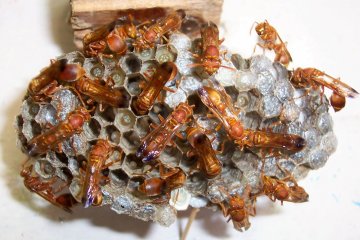If scientists kidnap all adult females from a wasp nest, the young males—which normally just hang around without working—will pitch in and feed at least some of the larvae, researchers find. This shows that male wasps have the wherewithal to do a job.

The scientists removed female workers from the nests of the southern Indian wasp Ropalidia marginata. The study is the first systematic test of job skills in a social bee or wasp, says Raghavendra Gadagkar of the Indian Institute of Science in Bangalore.
With help from Gadagkar’s colleague Ruchira Sen, the males came through. However, they fed larvae “less efficiently” than the regular nursemaids do, Gadagkar and Sen report in the February Animal Behaviour.
In the bees, wasps, and other social insects of the order Hymenoptera, females feed the young, hunt, and serve as soldiers. Males get their meals delivered and just wait around until it’s time to find a female to fertilize. In contrast, young male termites work along with their sisters.
In a few wasp species, biologists have on occasion observed males giving food to larvae.
The researchers brought 14 wasps’ nests into the lab. To make sure that the test wasps had enough to eat, Sen set dishes of food just outside the nests. In colonies where she had removed the females, the males didn’t go out to eat. Sen “mastered the art of patiently and tenderly hand-feeding the males,” says Gadagkar.
Males that Sen fed did some larva nannying, although not in the standard ways. They spent much longer than females do in preparing the food by chewing it into mush. During the chewing, a nursemaid drinks some of the juices before passing along the infant’s meal. Gadagkar and Sen are now testing whether the males siphon off a bigger share of the baby food than regular nursemaids do.
The males gave food only to the bigger, older larvae rather than to all larvae, as females do. The youngest larvae may be tricky to feed, Gadagkar speculates. The older larvae can more easily grab food.
The males also skipped steps in the feedings. After providing the chewed-up mush, a regular nursemaid takes a break to groom herself, then returns to the larva and regurgitates liquefied food and saliva for it. The males just groomed themselves and moved on. Nor did males make the females’ gestures of fanning their wings and drumming their antennae against the larvae’s cells.
“It’s quite an interesting finding because they test hypotheses about not just what males do but what they can do under certain circumstances,” says insect behaviorist Samuel Beshers of the University of Illinois at Urbana-Champaign.
The experiment is “a clever idea,” comments Sean O’Donnell of the University of Washington in Seattle, who has studied male roles in wasp colonies. “The question of why there are not male workers [among social Hymenoptera] is an important and unresolved one,” he says.






